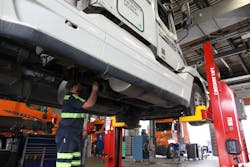Lifting standards
Helping make vehicle maintenance and repairs easier and safer for technicians, lifts used to raise trucks and tractors, trailers and buses are essential tools in most fleet shops. At the same time, lifts should be purchased and used with an understanding of their certification requirements and inspection needs.“The standard covering the design, construction and testing of lifts in North America is ANSI/ALI ALCTV,” says R.W. “Bob” O’Gorman, president of the Automotive Lift Institute (ALI), a trade association of North American-based lift manufacturers that promotes the safe design, construction, installation, service, inspection and use of lifts. The ANSI/ALI ALCTV standard provides electrical, strength and speed requirements for lifts, and addresses the lift manufacturer’s quality assurance systems and procedures,” O’Gorman explains. “A gold ALI certification label on a lift serves as proof that the lift’s design is compliant with the standard and that it has been third-party tested by an OSHA-accredited, Nationally Recognized Testing Laboratory.”There are no OSHA requirements at the federal level specifically citing a provision for automotive lifts. However, O’Gorman notes, health and safety officials reference national standards when issuing citations for lift operations where there is an observed lack of maintenance or training, or when investigating an accident involving a lift, operator or raised vehicle.“In addition to ANSI/ALI ALCTV, it is important for lift owners to be familiar with ANSI/ALI ALOIM, the national standard covering vehicle lift operation, inspection and maintenance,” O’Gorman states. “This standard requires that lifts be inspected annually by a qualified lift inspector, and it also provides guidance to the lift owner about how to document lift inspections, maintenance and operator training.”Lift manufacturers offer a range of products for the capacity of trucks, tractors and buses that meet current standards. Included are in-ground lifts, which raise a vehicle by its axles, and two-post lifts that feature two sets of lifting arms attached to two columns that are manually positioned under a vehicle to lift it at designated pick-up points on the frame.Drive-on style lifts, in four-post and parallelogram designs, have runways that are raised once the vehicle is in position. These lifts can be fitted with rolling jacks to raise a vehicle’s wheels as well as alignment systems. Also offered are mobile column lifts that consist of four or six portable columns linked by a common control circuit, and pit lifts that are added to existing service pits.More information on all types of lifts are available from manufacturers, including ARI-HETRA, Mohawk Lifts and Rotary Lift.For fleets looking for lift inspectors, ALI has created its Lift Inspector Certification Program to provide third-party qualification of vehicle lift inspectors in accordance with the ANSI standards governing vehicle lift inspection and in support of OSHA’s General Duty Clause. The association maintains a directory of certified lift inspectors and lift manufacturers so fleets can select approved products and locate local lift inspection service providers using an interactive database. More information is available at www.autolift.org.
